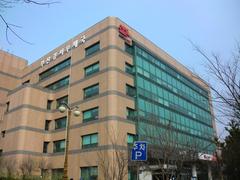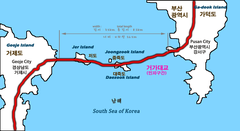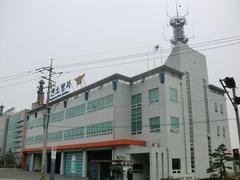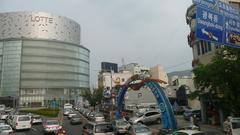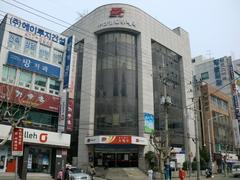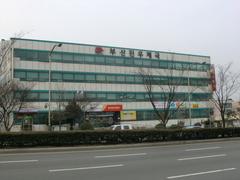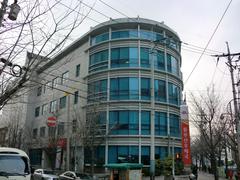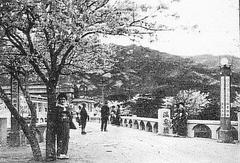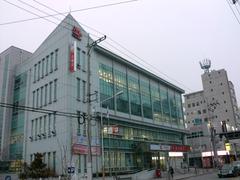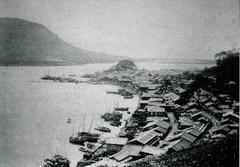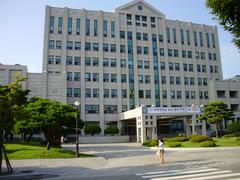Busan Gangseo Police Station Visiting Hours, Tickets, and Tourist Guide
Date: 03/07/2025
Introduction to Busan Gangseo Police Station and Its Significance
Busan Gangseo Police Station serves as a vital public safety institution in Gangseo-gu, a district that balances urban development, industrial zones, and significant infrastructure such as Gimhae International Airport. Established to address the evolving needs of a rapidly growing community, the station not only protects residents and visitors but also embodies the integration of tradition and innovation within South Korea’s modern law enforcement system. Visitors can gain unique insights into the area’s history and social dynamics, as well as South Korea’s approach to public safety and community engagement (National Police Agency (South Korea) - Wikipedia).
The station offers accessible services, multilingual support, and community programs designed to foster safety and cultural integration. Its central location near attractions like Nakdong River Riverside Park and Haedong Yonggungsa Temple makes it a convenient waypoint for travelers seeking both practical assistance and cultural exploration (Busan Gangseo-gu Guide; Haedong Yonggungsa Temple Official Info).
This guide delivers essential details on visiting hours, accessibility, transportation, and practical tips for engaging with the Busan Gangseo Police Station. It also highlights the station’s modernization initiatives, public safety efforts, and the rich historical and natural sites nearby, helping both residents and travelers make the most of their visit to Gangseo-gu.
Table of Contents
- Historical Evolution of Policing in Busan and Gangseo District
- Significance in Local Governance and Public Safety
- Visitor Information for Busan Gangseo Police Station
- Special Events and Community Programs
- Modernization and Technological Advancements
- Community Engagement and Cultural Integration
- Preservation of Historical and Cultural Heritage
- Statistical Overview
- Role in the National Police Structure
- Notable Incidents and Community Impact
- Visitors’ Frequently Asked Questions (FAQ)
- Exploring Busan Gangseo Police Station: A Community Landmark in Gangseo-gu
- Busan Gangseo Police Station Visitor Guide: Essential Information for Travelers
- Gangseo District Historical Sites: Exploring Haedong Yonggungsa Temple in Busan
Historical Evolution of Policing in Busan and Gangseo District
Early Foundations of Korean Policing
Modern Korean policing originated with the Police Department of the Provisional Government of the Republic of Korea in 1919. Under Commissioner General Kim Gu, the force prioritized protecting government officials and maintaining security among overseas Korean communities. Notably, a neighborhood patrol force formed in Shanghai in 1923 evolved into the Korean Patriotic Organization, playing a key role in anti-colonial resistance (National Police Agency (South Korea) - Wikipedia).
Post-Liberation and the Birth of Local Police Agencies
After Korea’s liberation in 1945, the US Army Military Government established the Police Administration Bureau, initially relying on the colonial police infrastructure. By 1948, police agencies were organized in each city and province, marking the start of a localized and structured approach to law enforcement that paved the way for the formation of the Busan Metropolitan Police Agency and its district branches, including Gangseo (National Police Agency (South Korea) - Wikipedia).
Development of the Busan Gangseo Police Station
Gangseo District’s strategic location near the Nakdong River and Gimhae International Airport contributed to its transformation from a rural area into a dynamic urban district. The establishment of the Busan Gangseo Police Station responded to the area’s unique challenges, including industrialization, urbanization, and increased population density (Busan Gangseo-gu Guide). The station’s jurisdiction covers residential neighborhoods, industrial complexes, and critical transport infrastructure.
Significance in Local Governance and Public Safety
The station’s key responsibilities include:
- Community Policing: Actively engaging with residents to address safety concerns and foster trust.
- Traffic Management: Overseeing road safety in an area with major highways and the airport.
- Tourist Assistance: Supporting the Korea Tourist Police initiative, especially in high-traffic areas (National Police Agency (South Korea) - Wikipedia).
- Emergency Response: Coordinating with fire, medical, and disaster teams, crucial given the district’s geography and infrastructure.
Visitor Information for Busan Gangseo Police Station
- Visiting Hours: Monday–Friday, 9:00 AM – 6:00 PM (public areas); tours by appointment.
- Entry and Tickets: Admission is free; contact the station in advance for tours or educational visits.
- Accessibility: The station offers wheelchair access and nearby parking. Public transport options include multiple buses and proximity to Gangseo Bus Terminal.
- Location: 123 Gangseo-ro, Gangseo-gu, Busan, near Gimhae International Airport.
- Travel Tips: Carry valid identification. Photography is permitted only in designated zones; security areas are restricted.
- Nearby Attractions: Nakdong River Riverside Park, Busan Museum of Modern Art, and local markets.
Special Events and Community Programs
- Annual Safety Fair: Showcases public safety technology and programs.
- Festival Security: Coordinates safety for events like the Busan Nakdong River Rape Flower Festival.
- Educational Workshops: Offers sessions on crime prevention and emergency preparedness.
Modernization and Technological Advancements
The station leverages advanced communication tools, surveillance systems, and eco-friendly vehicles, participating in national initiatives such as the Anti Cyber Terrorism Center and Special Operations Unit (National Police Agency (South Korea) - Wikipedia).
Community Engagement and Cultural Integration
With a diverse population, the station runs:
- Safety Education: Workshops for students and seniors.
- Multilingual Services: Support for non-Korean speakers, especially at the airport and tourist sites.
- Festival Security: Maintains safety during major festivals (Busan Gangseo-gu Guide).
Preservation of Historical and Cultural Heritage
Gangseo Police Station works with local authorities to protect heritage sites, manage event crowds, and support conservation initiatives (Busan History and Heritage).
Statistical Overview
- Jurisdiction Area: 179.05 km²
- Population Served: Approx. 120,000 (2025)
- Personnel: Officers specializing in cybercrime, traffic, and community outreach
Role in the National Police Structure
Operating under the Busan Metropolitan Police Agency, the station benefits from national resources and localized operational flexibility (National Police Agency (South Korea) - Wikipedia).
Notable Incidents and Community Impact
Gangseo Police Station’s proactive approach has led to declining crime rates and increased public trust, supported by regular community feedback.
Visitors’ Frequently Asked Questions (FAQ)
Q1: Can visitors tour the Busan Gangseo Police Station?
A1: Yes, by appointment. Contact the station in advance.
Q2: Is there an admission fee?
A2: No, entry is free.
Q3: Are there restrictions on photography?
A3: Permitted in public areas; restricted in sensitive zones.
Q4: How can I get there by public transport?
A4: Accessible by local buses and near Gangseo Bus Terminal, close to Gimhae International Airport.
Q5: Is the station accessible for disabled visitors?
A5: Yes, with wheelchair facilities.
Q6: Does the station assist foreign tourists?
A6: Yes, multilingual services are available in key locations.
Exploring Busan Gangseo Police Station: A Community Landmark
Location and Accessibility
Located in Gangseo-gu’s development hub, the station is accessible by bus, taxi, and near major projects like Eco Delta City.
- Address: 123 Gangseo-ro, Gangseo-gu, Busan
- Visiting Hours: 24/7 for emergencies; non-emergencies 9:00 AM–6:00 PM
- Transportation: Bus, taxi, and limited parking
What Visitors Can Expect
The station’s modern architecture and public information services make it visitor-friendly. Nearby attractions include Gangseo Marsh Ecological Park and Eco Delta City.
Community Programs and Events
Regularly hosts public safety seminars, outreach events, and educational programs on topics like cybercrime prevention.
Travel Tips
- Respect operational protocols; photography is restricted inside.
- Visit during business hours for non-emergency services.
- Enjoy nearby parks and cultural sites.
Essential Travel Information Table
| Aspect | Details |
|---|---|
| Address | Gangseo-gu, Busan, South Korea |
| Operating Hours | 24/7 (Admin: 9:00 AM–6:00 PM weekdays) |
| Emergency Number | 112 |
| Language Support | Limited English; translation apps recommended |
| Required Documents | Passport or Alien Registration Card (ARC) |
| Accessibility | Wheelchair accessible |
| Parking | Limited on-site; public lots nearby |
| Photography | Prohibited without permission |
| Nearest Metro | Daejeo Station (Busan Metro Line 3) |
Haedong Yonggungsa Temple: A Must-Visit Historical Site
Overview
Haedong Yonggungsa Temple, on Busan’s northeastern coast, is unique for its seaside location and panoramic ocean views. Founded in 1376, it is dedicated to Haesu Gwaneum Daebul (Haedong Yonggungsa Temple Official Info).
Visiting Hours and Tickets
- Hours: 5:00 AM–6:00 PM daily
- Tickets: Free admission
- Accessibility: Wheelchair accessible, with some stepped areas
Best Time to Visit & Photography
- Best Time: Spring and autumn
- Highlights: Sunrise views, golden Buddha statue, dragon staircase
How to Get There
- By Bus: Bus No. 181 to the temple
- By Car: Parking available
Nearby Attractions
- Songjeong Beach: Popular for relaxation
- Busan Aquarium: Family-friendly, 30 minutes away
Special Events
- Lotus Lantern Festival: May, featuring lantern displays and performances
- Guided Tours: Weekends, English and Korean; book via official tourism site
Visitor Tips
- Dress modestly and remove shoes in temple halls
- Speak softly and respect worshippers
- Photography allowed in most areas; avoid flash inside halls
Summary of Visiting Busan Gangseo Police Station and Travel Tips
The Busan Gangseo Police Station stands as a model of modern, community-oriented law enforcement, reflecting South Korea’s commitment to public safety and social integration (National Police Agency (South Korea) - Wikipedia). Its services, events, and proximity to historical and natural sites like Haedong Yonggungsa Temple and Gangseo Marsh Ecological Park make Gangseo-gu a destination for both practical needs and meaningful exploration (Haedong Yonggungsa Temple Official Info). Utilizing resources such as guided tours, attending public events, and staying updated via mobile applications ensures a safe and enriching experience in Busan.
References and Useful Links
- National Police Agency (South Korea) - Wikipedia
- Busan Gangseo-gu Guide
- Haedong Yonggungsa Temple Official Info
- Busan History and Heritage
- Busan Metropolitan Police Agency official site
Stay informed, stay safe! Download the Audiala app for real-time travel updates, emergency contacts, and more.


